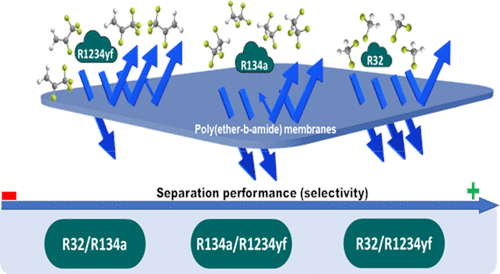当前位置:
X-MOL 学术
›
ACS Sustain. Chem. Eng.
›
论文详情
Our official English website, www.x-mol.net, welcomes your
feedback! (Note: you will need to create a separate account there.)
Separation of Refrigerant Gas Mixtures Containing R32, R134a, and R1234yf through Poly(ether-block-amide) Membranes
ACS Sustainable Chemistry & Engineering ( IF 7.1 ) Pub Date : 2020-02-06 , DOI: 10.1021/acssuschemeng.9b07195 Fernando Pardo 1 , Gabriel Zarca 1 , Ane Urtiaga 1
ACS Sustainable Chemistry & Engineering ( IF 7.1 ) Pub Date : 2020-02-06 , DOI: 10.1021/acssuschemeng.9b07195 Fernando Pardo 1 , Gabriel Zarca 1 , Ane Urtiaga 1
Affiliation

|
Hydrofluorocarbons (HFCs) are powerful greenhouse gases whose production and consumption must be phased down in order to reach the reduction goals established by the Kigali Amendment to the Montreal Protocol. However, the share of recycled refrigerant gases remains very low owing to the extremely inefficient separation of refrigerant mixtures by cryogenic distillation. In this sense, the HFCs, difluoromethane (R32, GWP = 675) and 1,1,1,2-tetrafluoroethane (R134a, GWP = 1430), together with the hydrofluoroolefin (HFO) 2,3,3,3-tetrafluoropropene (R1234yf, GWP = 4), are among the most common constituents of HFC/HFO refrigerant mixtures currently employed in the refrigeration and air-conditioning sector. Therefore, the feasibility of using membrane technology for the selective separation of these compounds is assessed in this work for the first time. A comprehensive study of their gas permeation through several poly(ether-block-amide) (PEBA) membranes that differ on the content and type of backbone segments is performed. Results show that PEBA membranes exhibit superior permeability of R32 (up to 305 barrer) and R134a (up to 230 barrer) coupled with reasonably high selectivity for the gas pairs R32/R1234yf (up to 10) and R134a/R1234yf (up to 8). Moreover, for the blends R32/R1234yf and R32/R134a, the membrane separation performance is not significantly affected under the mixed gas conditions tested. Thus, results evidence that consideration should be given to membrane technology for the cost-efficient separation of HFC/HFO mixtures in order to boost the recycling of these compounds.
中文翻译:

通过聚(醚嵌段酰胺)膜分离含R32,R134a和R1234yf的混合制冷剂
氢氟碳化合物(HFCs)是强大的温室气体,为了实现《蒙特利尔议定书》的《基加利修正案》确定的减排目标,必须减少其生产和消费。但是,由于通过低温蒸馏分离制冷剂混合物的效率极低,因此再循环制冷剂气体的份额仍然很低。从这个意义上讲,HFC,二氟甲烷(R32,GWP = 675)和1,1,1,2-四氟乙烷(R134a,GWP = 1430)以及氢氟烯烃(HFO)2,3,3,3-四氟丙烯( R1234yf,GWP = 4)是当前在制冷和空调领域使用的HFC / HFO制冷剂混合物的最常见成分。因此,首次在这项工作中评估了使用膜技术选择性分离这些化合物的可行性。进行了骨架部分的含量和类型不同的嵌段(PEBA)膜。结果表明,PEBA膜对R32(高达305 barrer)和R134a(高达230 barrer)表现出优异的渗透性,并且对R32 / R1234yf(高达10)和R134a / R1234yf(高达8)气体对具有相当高的选择性。 。此外,对于共混物R32 / R1234yf和R32 / R134a,在测试的混合气体条件下,膜分离性能没有受到明显影响。因此,结果表明,应考虑采用膜技术来经济高效地分离HFC / HFO混合物,以促进这些化合物的循环利用。
更新日期:2020-02-07
中文翻译:

通过聚(醚嵌段酰胺)膜分离含R32,R134a和R1234yf的混合制冷剂
氢氟碳化合物(HFCs)是强大的温室气体,为了实现《蒙特利尔议定书》的《基加利修正案》确定的减排目标,必须减少其生产和消费。但是,由于通过低温蒸馏分离制冷剂混合物的效率极低,因此再循环制冷剂气体的份额仍然很低。从这个意义上讲,HFC,二氟甲烷(R32,GWP = 675)和1,1,1,2-四氟乙烷(R134a,GWP = 1430)以及氢氟烯烃(HFO)2,3,3,3-四氟丙烯( R1234yf,GWP = 4)是当前在制冷和空调领域使用的HFC / HFO制冷剂混合物的最常见成分。因此,首次在这项工作中评估了使用膜技术选择性分离这些化合物的可行性。进行了骨架部分的含量和类型不同的嵌段(PEBA)膜。结果表明,PEBA膜对R32(高达305 barrer)和R134a(高达230 barrer)表现出优异的渗透性,并且对R32 / R1234yf(高达10)和R134a / R1234yf(高达8)气体对具有相当高的选择性。 。此外,对于共混物R32 / R1234yf和R32 / R134a,在测试的混合气体条件下,膜分离性能没有受到明显影响。因此,结果表明,应考虑采用膜技术来经济高效地分离HFC / HFO混合物,以促进这些化合物的循环利用。











































 京公网安备 11010802027423号
京公网安备 11010802027423号